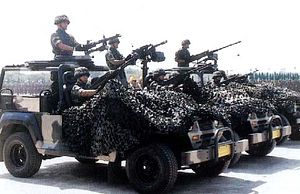What could the Philippines buy from Russia or China?
As the Diplomat has reported, Philippine President Duterte has suggested that his Department of National Defense look into acquiring weapons from Russia and China. These weapons would presumably replace those supplied by the United States, which have constituted the greater portion of Filipino military stocks for some time. This is part of Duterte’s longer-term commitment to re-thinking the Philippine’s role in Southeast Asia.
What would Duterte want? The Philippine’s need for modern military equipment is substantial, although its resources are fairly meager. In recent years Manila has concentrated on helicopters, light aircraft, light patrol boats, and a variety of munitions. Much of this has come from the United States, although Japan has also played a role in supporting Manila’s maritime ambitions. However, either Russia or China could ably fulfill these relatively modest requirements. The Chinese JF-17 fighter would fit Philippine requirements nicely, as would refurbished MiG-29 models (Duterte has already criticized a deal to acquire modernized F-16s). Altogether, while capturing the Philippines military market would be only moderately lucrative, it would fall right into the wheelhouse of either the Russian or Chinese military-industrial complexes.
A more tense relationship between Manila and Washington could cause other problems, involving technology transfer. The Philippines is one of the major customers for South Korea’s KAI T-50 Golden Eagle trainer/light fighter/light attack aircraft. Because KAI developed the program in collaboration with Lockheed Martin, however, the United States has an effective veto over export of the plane. While this would likely not affect the current delivery schedule, and in any case would be a big step for the United States to take, holding the T-50 hostage is one option in Washington’s toolkit. Of course, Duterte has already spoken dismissively of the T-50, so a veto might not have much effect on his decision-making.
There would also be some risk to Russia and China for taking Duterte seriously on his commitment to purchase their equipment. The U.S. Department of Defense has deep, long-standing relations with the military of the Philippines, and those relationships wont deteriorate overnight. The United States already has access to advanced Russian military equipment through an array of exercises with partners such as Malaysia, Indonesia, and India, but if Duterte’s successors see greater value in a return to the U.S. alliance, Russian or Chinese military equipment could undergo even more substantial American scrutiny.
Generally speaking, however, reorienting an entire procurement system from the United States to Russia or China would take an enormous amount of time, money, and bureaucratic effort. We can expect that Filipino military and procurement officials would likely attempt to slow-roll any new deals in the hope of waiting Duterte out, as the effort of integrating Russia, Chinese and American equipment would tax their already meager resources. Nevertheless, as with all things Duterte, the prospect of shifting acquisition merits continued attention from the United States, and from arms trade specialists.

































